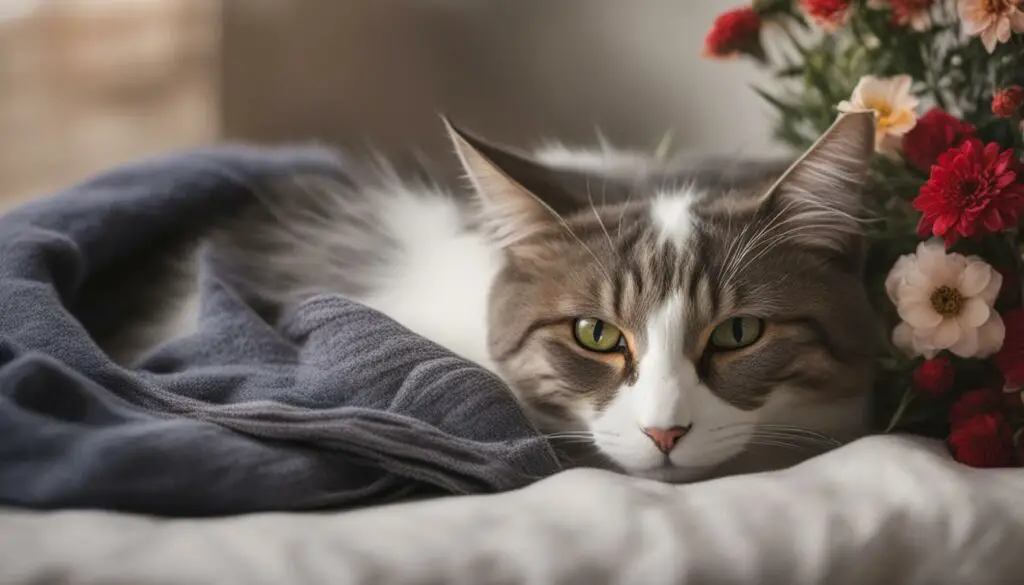As a cat owner, you may be wondering how long your feline friend will need to stay at the veterinarian’s office after being spayed. The duration of your cat’s stay can vary depending on several factors, but most cats are able to go home the same day as the surgery. However, some cats may require an overnight stay for monitoring.
It is important to follow your veterinarian’s instructions for post-surgery care to ensure a smooth recovery for your cat. This includes providing proper pain management, monitoring the incision site, and keeping an eye out for any signs of complications. By taking good care of your cat during this crucial time, you can help speed up the healing process and ensure their overall well-being.
Remember, every cat is unique, and their recovery time may vary. It is essential to consult with your veterinarian for specific guidance tailored to your cat’s individual needs.
Key Takeaways:
- The length of time a cat stays at the vet after being spayed can vary.
- Most cats are able to go home the same day as the surgery.
- Some cats may require an overnight stay for monitoring.
- Follow your veterinarian’s post-surgery care instructions for a smooth recovery.
- Consult with your veterinarian for specific guidance tailored to your cat’s needs.
Types of Cat Spaying Procedures
When it comes to spaying cats, there are two main types of procedures that veterinarians perform: ovariohysterectomy and ovariectomy. Ovariohysterectomy involves the removal of both the uterus and ovaries, while ovariectomy only removes the ovaries.
Most veterinarians prefer to perform ovariohysterectomy as it provides additional benefits, such as reducing the risk of uterine cancer and complications related to the uterus. Ovariectomy, on the other hand, is a less invasive procedure that only removes the ovaries.
In recent years, laparoscopic spay procedures have also become increasingly popular. This technique involves making smaller incisions and using a camera to assist with the removal of the reproductive organs. Laparoscopic spays offer less postoperative pain, quicker recovery times, and reduced risk of complications compared to traditional open surgeries.
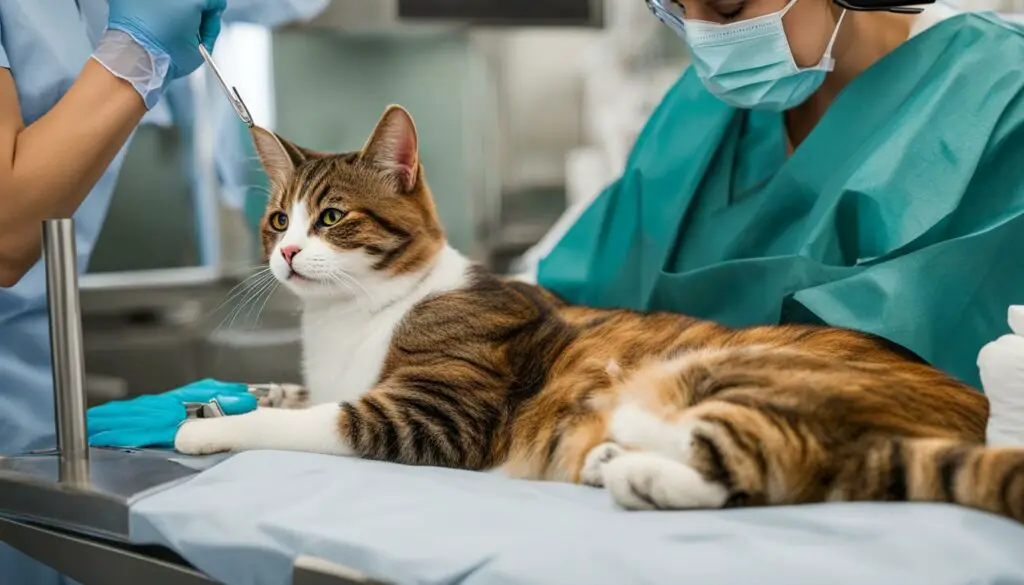
Comparing Ovariohysterectomy and Ovariectomy
| Procedure | Uterus Removal | Ovary Removal | Invasiveness | Benefits |
|---|---|---|---|---|
| Ovariohysterectomy | Yes | Yes | More invasive | Reduced risk of uterine cancer and complications |
| Ovariectomy | No | Yes | Less invasive | Reduced recovery time and risk of complications |
It’s important to note that the specific procedure performed may vary depending on the veterinarian’s preference, the cat’s age and health condition, and any additional medical considerations. Your veterinarian will be able to provide guidance on which spay procedure is best for your cat based on their individual needs.
Post-Surgery Care for Cats After Spaying
After your cat undergoes spaying surgery, it is crucial to provide proper post-surgery care to ensure a smooth recovery. During the initial hours and days following the procedure, it is important to monitor your cat for any signs of potential issues or complications. Some common signs to watch out for include a lack of appetite, weakness or lack of energy, a swollen midsection, changes in respiratory rate, diarrhea and vomiting, and difficulty urinating.
Following the surgery, your veterinarian will provide you with specific at-home care instructions tailored to your cat’s needs. These instructions may include restricting physical activities to prevent strain on the incision site, monitoring the surgical site for any signs of infection or abnormal discharge, ensuring that your cat keeps her E-collar or surgical healing shirt on to prevent licking or scratching the incision, and providing close monitoring during the first 12-24 hours post-surgery.
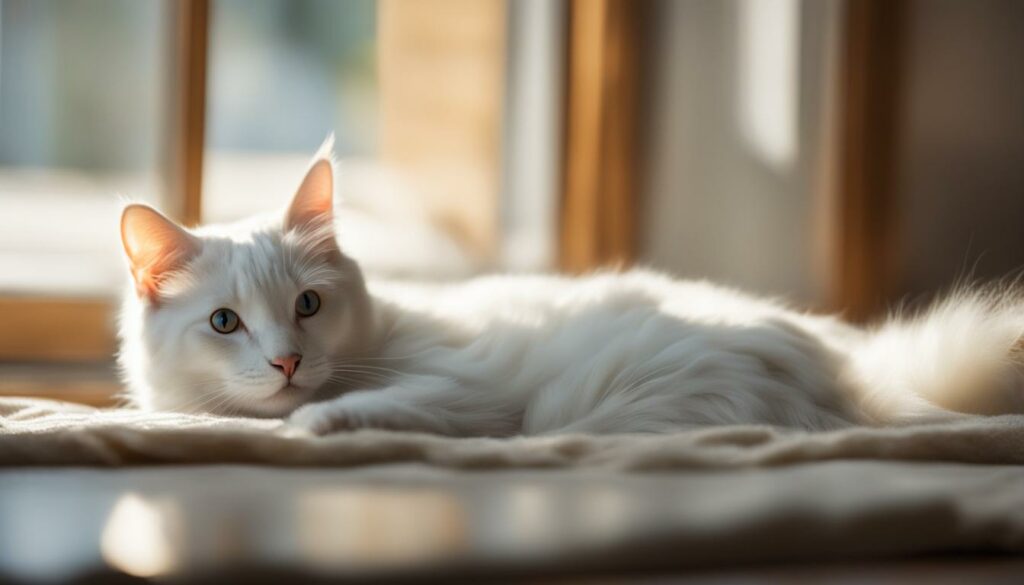
| Signs of Potential Issues After Spaying | What to Do |
|---|---|
| Lack of appetite, weakness, or lack of energy | Contact your veterinarian if these symptoms persist or worsen. |
| Swollen midsection | Monitor the swelling and contact your vet if it appears excessive or does not improve. |
| Changes in respiratory rate | Ensure your cat’s breathing is not labored or irregular. Contact your vet if you notice any abnormalities. |
| Diarrhea and vomiting | Monitor your cat’s bowel movements and contact your vet if the diarrhea or vomiting persists or becomes severe. |
| Difficulty urinating | If your cat is unable to urinate or has not passed urine for 24 hours or more, seek immediate veterinary care. |
By closely following the post-surgery care instructions provided by your veterinarian and being vigilant for any signs of potential issues, you can help ensure a smooth recovery for your cat after spaying surgery.
Proper Healing of the Incision
After your cat has been spayed, proper healing of the incision is crucial for a successful recovery. It is important to monitor the incision site for any signs of infection or complications. Here are some key points to keep in mind:
- Normal Healing Process: It is normal for the incision site to be slightly red and swollen for the first 24 hours. Some pinkish or slightly bloody discharge may also be present. However, if you notice excessive inflammation, redness, swelling, foul odor, or discharge, it could indicate an issue with the healing process.
- Monitoring Sutures: Keep a close eye on the sutures to ensure they remain intact. Any signs of the sutures coming undone or the wound opening should be reported to your veterinarian immediately.
- Preventing Infection: To prevent infection, it is important to keep the incision area clean and dry. Avoid letting your cat lick or chew at the incision site, as this can introduce bacteria. Your veterinarian may provide you with an Elizabethan collar or a surgical healing shirt to prevent your cat from accessing the incision.
If you notice any concerning signs or have any doubts about the healing process, it is always best to contact your veterinarian for guidance. They can evaluate the incision site and provide appropriate treatment if necessary.
To give you a better idea of what to expect, here is a table summarizing the normal healing process and signs of incision complications:
| Normal Healing Process | Signs of Incision Complications |
|---|---|
| Redness and slight swelling for the first 24 hours | Excessive inflammation or swelling |
| Pinkish or slightly bloody discharge | Foul odor or discharge |
| Healing progress within 10-14 days | Wound opening or sutures coming undone |
| Incision remains intact | Delayed healing or prolonged recovery |
Remember, it is always important to follow your veterinarian’s instructions and seek their guidance if you have any concerns about the healing process. By providing proper care and monitoring, you can help ensure a smooth and successful recovery for your cat.

Post-Surgical Pain Management for Cats
After undergoing spaying surgery, cats may experience some level of pain or discomfort. It is crucial to manage their pain effectively to ensure a smooth recovery process. Your veterinarian will prescribe appropriate pain medications to keep your cat comfortable during this time. It is important to follow the medication instructions provided by your vet and administer the medications as directed.
One key point to remember is that you should never give human medications to your cat without veterinary approval. Some human medications can be toxic to cats and may have adverse effects on their health. It is always best to stick to the prescribed pain medication specifically formulated for feline use.
Completing the full course of prescribed medication is also important. Even if your cat appears to be feeling better or showing signs of improvement, it is crucial to continue administering the medication as instructed. This will help prevent post-surgery complications and ensure your cat’s comfort throughout the recovery period.
Pain Medications for Cats:
| Pain Medication | Administration | Frequency |
|---|---|---|
| Medication A | Oral | Every 12 hours |
| Medication B | Injectable | Every 24 hours |
| Medication C | Transdermal patch | Once every 72 hours |
By effectively managing your cat’s post-surgical pain, you can contribute to their overall comfort and well-being during the recovery process. If you have any concerns or questions regarding pain management or your cat’s medication, don’t hesitate to reach out to your veterinarian for guidance.
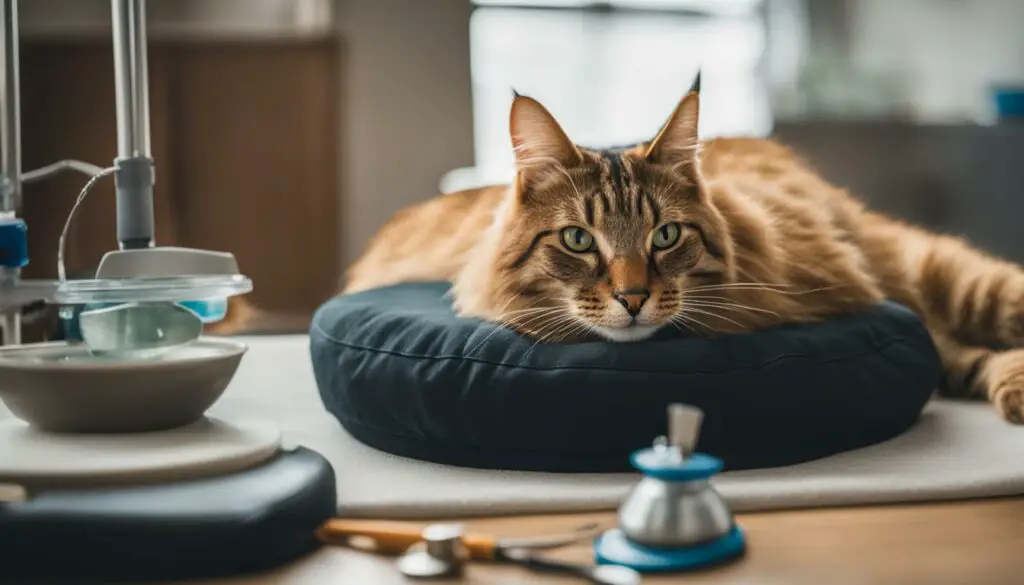
Post-Surgery Litterbox Use
Proper litterbox use is crucial during your cat’s recovery after spaying surgery. Monitoring your cat’s urination and bowel movements is important to ensure everything is functioning properly. After surgery, it is normal for cats to experience some constipation or diarrhea due to anesthesia and changes in diet. However, if your cat is unable to pass urine for 24 hours or more, it is a medical emergency and you should contact your veterinarian immediately.
“Monitoring your cat’s litterbox habits is essential to ensure a smooth recovery.”
It is important to keep an eye on your cat’s stool consistency and make sure they are able to pass stool within 48 hours after surgery. Mild constipation or diarrhea can be expected, but persistent diarrhea or inability to pass stool should be reported to your vet. Avoid giving over-the-counter medications or human food without veterinary approval, as they may interfere with the healing process. If you have any concerns about your cat’s litterbox habits or digestive health, don’t hesitate to contact your veterinarian for guidance.
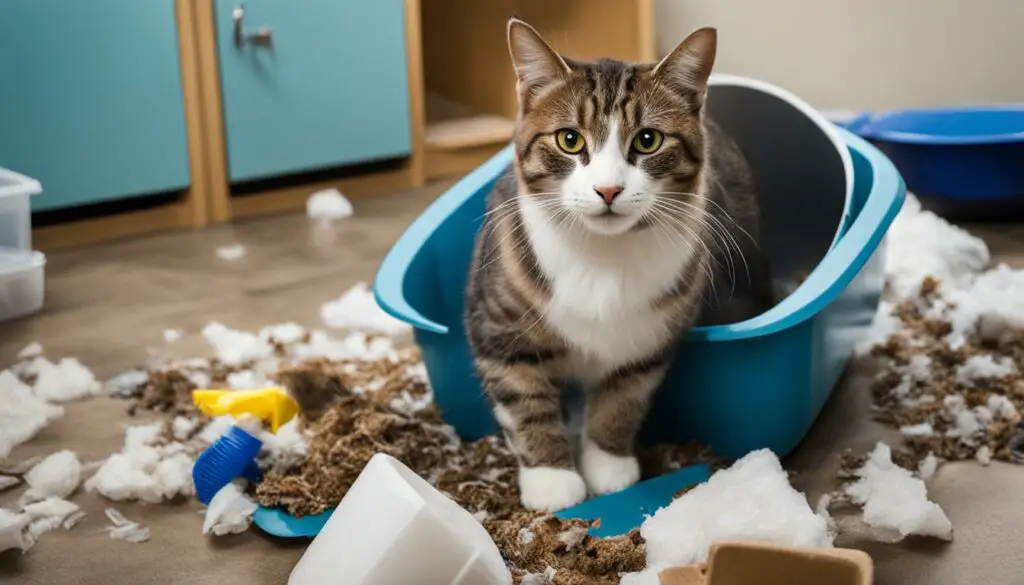
Table: Monitoring Signs for Post-Surgery Litterbox Use
| Signs | What to Look For |
|---|---|
| Lack of urination | No urine passed for 24 hours or more |
| Constipation | No stool passed for more than 48 hours |
| Diarrhea | Consistent loose or watery stools |
Feeding Your Cat After Spay Surgery
After spay surgery, it is important to pay attention to your cat’s post-surgery appetite and follow the feeding instructions provided by your veterinarian. The surgery and medications used during the procedure may temporarily reduce your cat’s appetite. However, within 24-48 hours, your cat’s appetite should gradually return to normal.
During the recovery period, it is crucial to follow the feeding instructions provided by your vet. Avoid giving any additional food or treats for at least a week, as it can disrupt the healing process. Some medications used during the surgery may cause reduced appetite or nausea, so it’s important to be patient and provide your cat with a calm and comfortable environment during meal times.
If you have concerns about your cat’s eating habits or notice a persistent lack of appetite, it is advisable to contact your veterinarian for guidance. They can provide specific recommendations based on your cat’s individual needs and recovery progress.
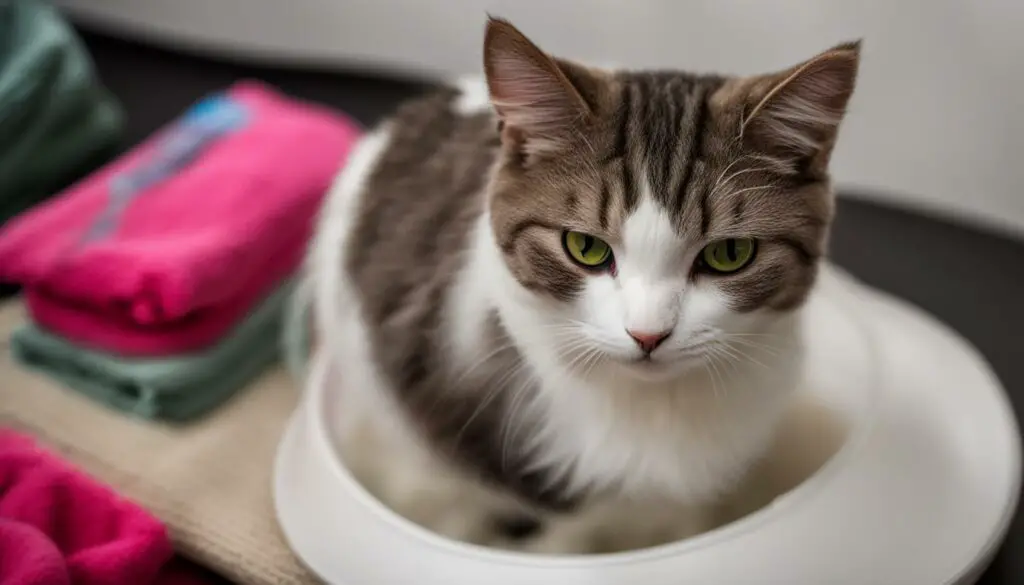
Remember, a healthy and balanced diet is essential for your cat’s overall well-being, especially during the recovery period after spay surgery. By following the feeding instructions provided by your veterinarian and monitoring your cat’s appetite, you can contribute to a successful and smooth recovery.
What to Expect Before Surgery
Before your cat undergoes spaying surgery, there are a few things to expect and prepare for. Firstly, it is important to limit your cat’s activity in the days leading up to the surgery. This helps reduce the risk of injury and ensures a smoother procedure and recovery. Avoid allowing your cat to engage in vigorous activities such as running or jumping, as it may interfere with the surgical process.
It is also essential to continue feeding your cat their regular diet until the night before the surgery. This helps maintain their overall health and ensures they have the necessary nutrients for optimal healing. Giving your cat a consistent diet also helps minimize any digestive issues that may arise post-surgery.
Lastly, keeping the incision area dry is crucial before the surgery. Refrain from bathing your cat or applying any ointments to the area unless specifically instructed by your veterinarian. This helps prevent any potential infections and ensures a clean surgical site for the procedure.
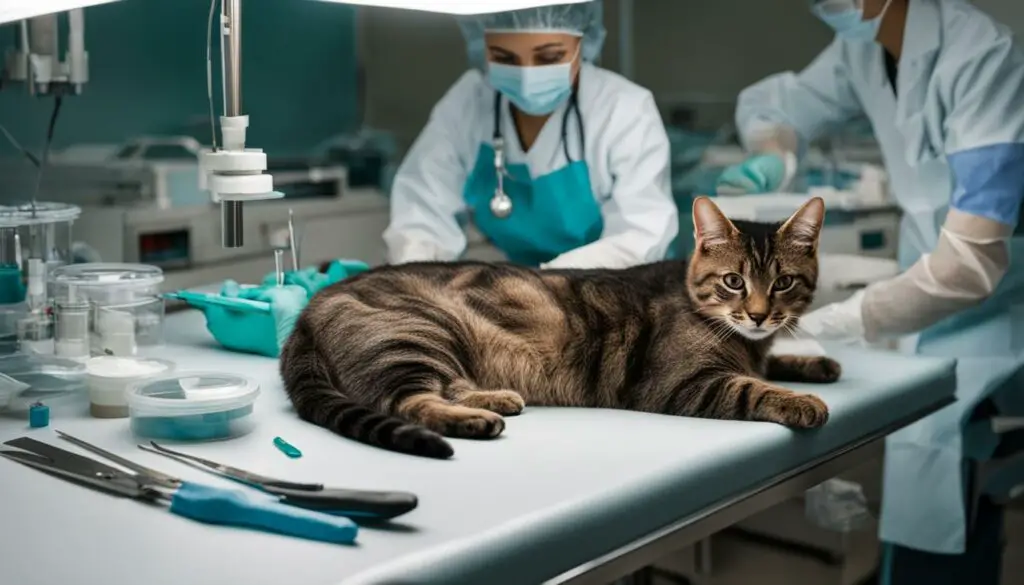
What to Expect Before Surgery
| Expectations | Actions |
|---|---|
| Limiting Activity | Keep your cat’s activity level low to reduce the risk of complications. |
| Regular Diet | Continue feeding your cat their regular diet until the night before the surgery. |
| Keeping Incision Dry | Avoid bathing your cat or applying ointments to the incision area before the surgery. |
By following these preparations, you can ensure that your cat is ready for the spaying surgery and increase the likelihood of a successful procedure and smooth recovery.
The Spay Procedure
When it comes to spaying a cat, the procedure involves the removal of the female reproductive organs, including the ovaries, uterus, and uterine horns. This surgery is typically performed under general anesthesia to ensure the comfort and safety of the cat. The length of the spay procedure can vary depending on factors such as the size of the cat and any additional medical considerations, ranging from 20 to 90 minutes.
During the spay procedure, the veterinarian will make an incision in the abdomen to access the reproductive organs. The surgical techniques used may vary, but the goal is to remove the reproductive organs completely to prevent the cat from going into heat and reduce the risk of certain reproductive-related diseases, such as uterine cancer and pyometra.
After the spay procedure is complete, the cat will need time to recover from the effects of anesthesia. It can take a few hours for the cat to fully wake up and regain consciousness. Following the surgery, it is important to provide a quiet and comfortable recovery space for the cat, ensuring they have access to fresh water, a litter box, and a soft bed to rest on. The veterinarian will provide post-surgical care instructions, including information on pain management, incision care, and any necessary follow-up appointments.
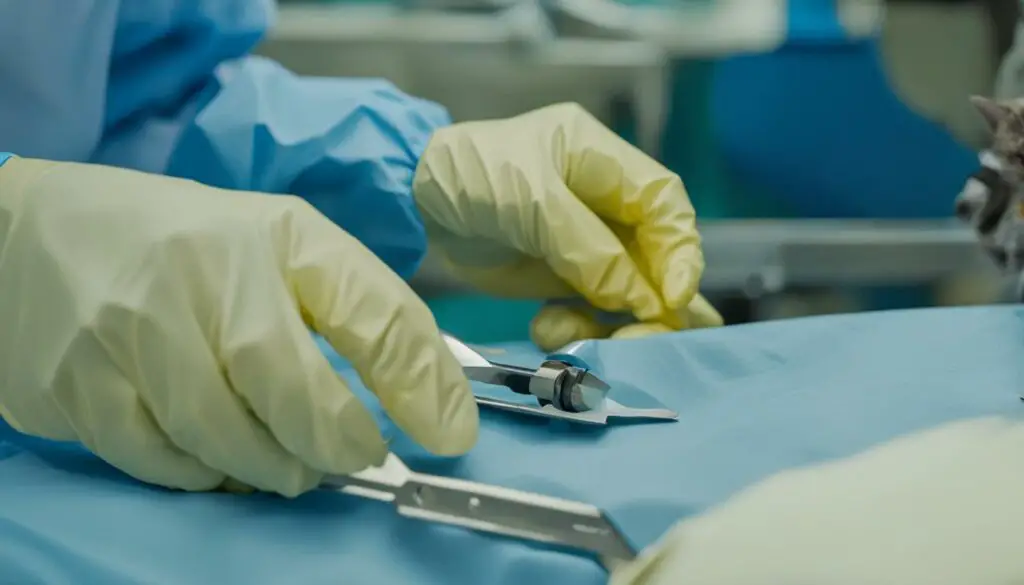
Table: Surgical Techniques for Cat Spaying
| Technique | Description |
|---|---|
| Ovariohysterectomy | This technique involves the removal of the uterus and ovaries, providing the most comprehensive sterilization. It is the most common method used in spaying cats. |
| Ovariectomy | This technique involves the removal of only the ovaries, leaving the uterus intact. It is less commonly used but may be suitable for certain cats, such as those with a pre-existing uterine condition. |
| Laparoscopic Spay | This minimally invasive technique uses small incisions and specialized tools to remove the reproductive organs. It can result in less pain and a quicker recovery for the cat. |
Recovery After Spaying Surgery
After your cat undergoes spaying surgery, it is essential to ensure a proper and smooth recovery. The duration of the recovery period can vary, but most cats start feeling better within 24-48 hours. However, it is important to note that full recovery may take up to 10-14 days. During this time, it is crucial to limit your cat’s activity to prevent any complications or reopening of the incision. Rest is key to a successful recovery, so avoid allowing your cat to engage in vigorous activities such as running, jumping, or playing for at least 7-10 days.
Aside from limiting activity, checking the incision site is also vital. Monitor the incision at least twice daily for any signs of infection or complications, such as redness, swelling, discharge, or foul odor. If you notice anything concerning, it is important to contact your veterinarian for further guidance. They can provide appropriate advice or recommend further treatment if needed.
Furthermore, monitoring your cat’s behavior is essential during the recovery period. Keep an eye on their appetite, activity level, and overall demeanor. While it is normal for cats to be a bit groggy or sleepy after surgery, any concerning changes in behavior or prolonged lethargy should be reported to your veterinarian. They can assess the situation and provide guidance to ensure a successful recovery.
| Recovery Tips After Spaying Surgery |
|---|
| Limit your cat’s activity for 7-10 days. |
| Check the incision site regularly for signs of infection or complications. |
| Monitor your cat’s behavior and contact your veterinarian if you notice any concerning changes. |
Remember, every cat is unique, and their recovery process may vary. It is essential to follow your veterinarian’s instructions and seek professional advice if you have any concerns or questions throughout the recovery period. By providing proper care and monitoring, you can contribute to your cat’s successful healing and overall well-being.
What to Expect After Surgery
After your cat undergoes spaying surgery, it is important to have realistic expectations and be aware of the normal signs that can occur during the recovery process. While each cat’s experience may vary, there are some common post-surgery signs to look out for.
- Restlessness: It is normal for your cat to be a bit restless after surgery. They may be disoriented or have difficulty finding a comfortable position to rest.
- Temporary changes in behavior: Your cat may exhibit temporary changes in behavior, such as being more withdrawn or less interested in play. This is usually a result of the anesthesia wearing off and should improve as they recover.
- Sleeping more than usual: Your cat may sleep more than usual during the initial recovery period. This is their body’s way of healing and conserving energy.
While these signs are generally normal, it is important to monitor your cat closely for any signs of complications. Contact your veterinarian if you notice any of the following:
- Pale gums
- Extreme lethargy
- Vomiting
- Diarrhea
- Discharge or bleeding from the incision
- Difficulty urinating
- Labored breathing
These symptoms could indicate a potential complication, and it is important to seek veterinary advice promptly to ensure your cat’s well-being.
| Normal Post-Surgery Signs | Signs of Complications |
|---|---|
| Restlessness | Pale gums |
| Temporary changes in behavior | Extreme lethargy |
| Sleeping more than usual | Vomiting |
| Diarrhea | |
| Discharge or bleeding from the incision | |
| Difficulty urinating | |
| Labored breathing |
Note: The table above summarizes the normal post-surgery signs and signs of complications to help you differentiate between the two. It is important to consult your veterinarian if you have any concerns or questions regarding your cat’s recovery.
Limiting Activity and Proper Diet
After spaying surgery, it is crucial to limit your cat’s activity to ensure proper healing. Rest is essential to prevent complications or reopening of the incision. Avoid allowing your cat to engage in vigorous activities such as running, jumping, or playing for at least 7-10 days. This will give the surgical site time to heal and reduce the risk of any post-surgery complications. As a responsible cat owner, it is your responsibility to monitor and manage your cat’s physical activity during the recovery period.
Additionally, maintaining a regular diet is key to optimal healing and recovery. It’s important to continue feeding your cat its regular diet after the spay surgery. Avoid giving excessive treats or human food as this can disrupt your cat’s digestive system and hinder the healing process. Providing a balanced and nutritious diet will support your cat’s overall health and aid in a smooth recovery.
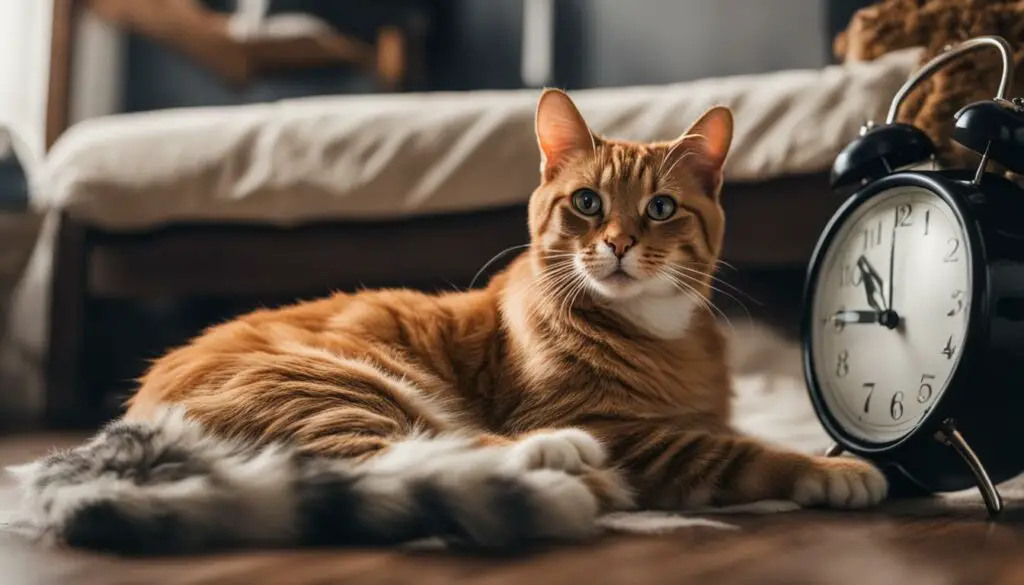
Importance of Rest for Proper Healing
Rest is crucial for your cat’s recovery after spaying surgery. It allows the body to focus its energy on healing and reduces the risk of complications. Avoiding physical strain ensures that the incision site remains undisturbed, promoting proper wound healing. Create a quiet and comfortable space for your cat to rest, away from any potential stressors or other pets. Provide soft bedding and a warm environment to help your cat feel safe and secure during the healing process.
The Role of Diet in Healing
A proper diet is essential for optimal healing after spaying surgery. Nutritious food provides the necessary nutrients to support the body’s healing processes. Consult your veterinarian for specific dietary recommendations that will promote healing and prevent any complications. Ensure that your cat has access to fresh water at all times to stay hydrated during the recovery period.
| Limiting Activity | Maintaining a Regular Diet | |
|---|---|---|
| Benefits |
|
|
| Tips |
|
|
By following these guidelines for limiting activity and maintaining a regular diet, you can contribute to your cat’s successful healing and ensure a smooth recovery after spaying surgery.
Monitoring the Incision and Pain Management
After your cat undergoes spaying surgery, it is crucial to closely monitor the incision site for any signs of infection or complications. Regularly check the area for redness, swelling, discharge, or a foul odor. These could indicate that the incision is not healing properly, and it is important to contact your veterinarian for further guidance and evaluation.
In addition to monitoring the incision, proper pain management is essential for your cat’s comfort during the recovery period. Your veterinarian will prescribe appropriate pain medications to help alleviate any discomfort. It is important to follow the medication instructions provided by your vet and administer the medication as directed. If you have any concerns or questions about your cat’s pain levels or the effectiveness of the medication, don’t hesitate to reach out to your veterinarian for guidance.
Proper pain management is crucial for your cat’s comfort during the recovery period.
Remember, as a pet owner, you play a vital role in your cat’s recovery. By carefully monitoring the incision site and diligently managing your cat’s pain, you can contribute to a successful healing process. Always stay in contact with your veterinarian and reach out to them if you have any concerns or questions regarding the incision site or your cat’s pain management.
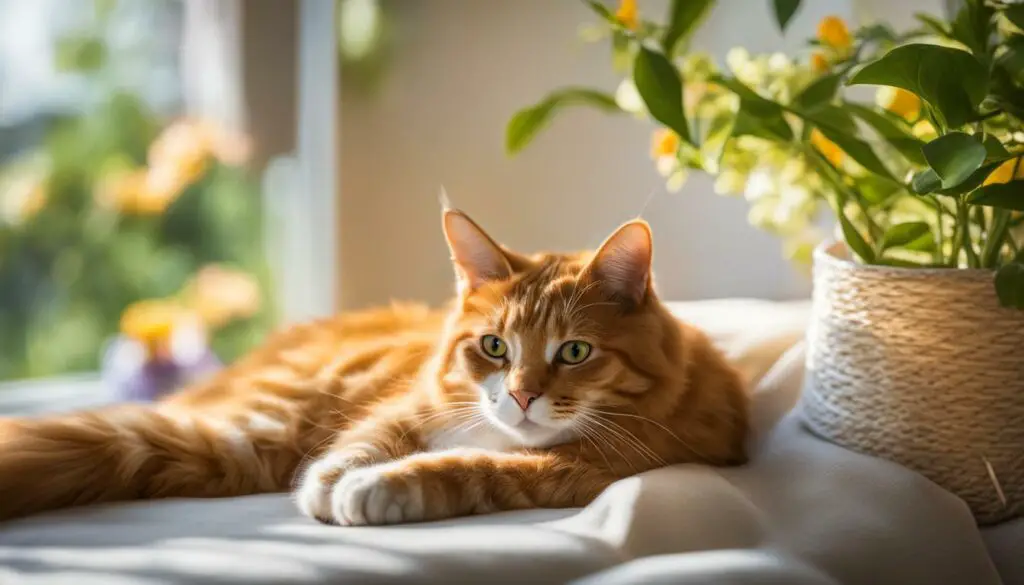
Ensuring Proper Healing and Follow-Up Care
After your cat undergoes spaying surgery, ensuring proper healing and providing appropriate follow-up care is essential for their overall well-being. It is important to follow your veterinarian’s instructions and keep an eye on any signs of complications or delayed recovery. Here are some key steps to take to ensure your cat’s proper healing:
Follow-Up Care Instructions
Once your cat is back home after the surgery, carefully follow the post-operative care instructions provided by your veterinarian. These may include keeping the incision site clean and dry, administering prescribed medications, and limiting physical activities. Your vet may also provide guidelines on feeding, monitoring litterbox habits, and checking the incision for any signs of infection or complications.
Sutures Removal
If your cat has external sutures or staples, they will usually need to be removed by your vet after 7-10 days. It is important to schedule this follow-up appointment and have the sutures removed to allow for optimal healing. In some cases, your vet may use absorbable sutures, which do not require removal.
Contacting the Vet for Extended Recovery Concerns
If you notice any unusual or concerning signs during the recovery period, it is crucial to contact your veterinarian for guidance. Signs of extended recovery may include persistent redness, swelling, discharge, or excessive pain at the incision site, as well as prolonged lethargy or loss of appetite. Your vet will be able to assess the situation and provide appropriate advice or recommend further evaluation if necessary.
By following these steps and staying in close communication with your veterinarian, you can ensure that your cat’s healing process is properly monitored and any potential complications are addressed promptly. Your vet is the best resource for guidance and support during this recovery period.
| Follow-Up Care Tips | Important |
|---|---|
| Follow your vet’s post-operative care instructions | ✓ |
| Keep the incision site clean and dry | ✓ |
| Administer prescribed medications as directed | ✓ |
| Limit physical activities | ✓ |
| Monitor the incision site for signs of infection or complications | ✓ |
| Schedule a follow-up appointment for suture removal | ✓ |
| Contact your vet if you have any concerns or notice unusual signs | ✓ |
Monitoring Overall Health and Recovery
During the recovery period after spaying surgery, it is important to closely monitor your cat’s overall health to ensure a successful and smooth recovery. By paying attention to signs of post-surgery complications and promptly contacting your veterinarian for guidance, you can provide the necessary care and support for your feline friend.
Keep an eye on your cat’s behavior, appetite, and activity level. It is normal for cats to be a bit lethargic and sleep more than usual after surgery. However, if you notice any extreme lethargy, persistent vomiting or diarrhea, or any other unusual symptoms, it is essential to reach out to your vet for advice.
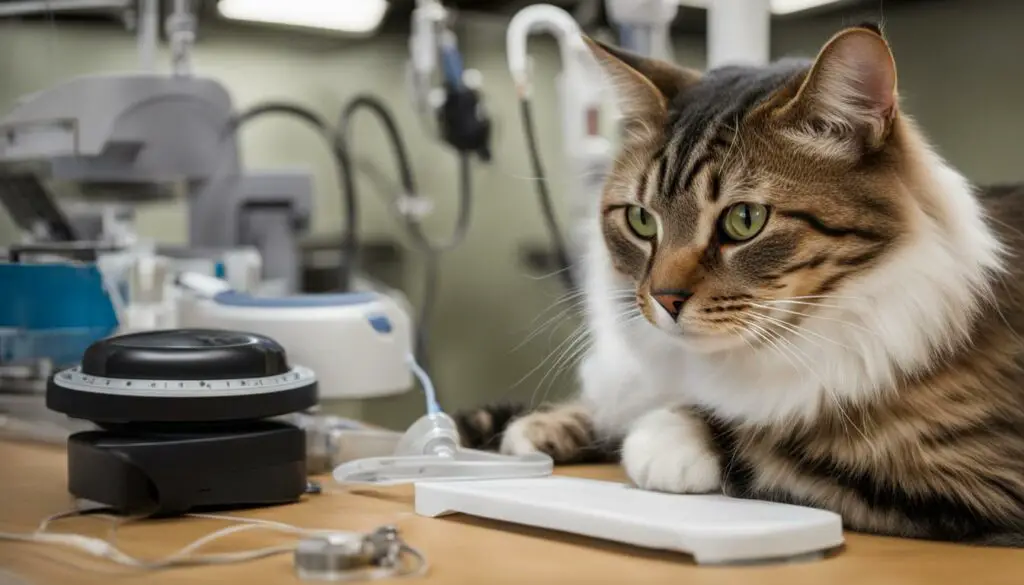
In addition to physical signs, observe your cat’s emotional well-being. Look out for any changes in their mood or behavior, such as increased aggression, excessive licking or grooming, or withdrawal. Cats can experience stress and anxiety during the recovery period, so providing a calm and soothing environment can help them feel more at ease.
Signs of Post-Surgery Complications
It is crucial to be aware of potential signs of post-surgery complications. These can include excessive swelling or redness around the incision site, discharge with a foul odor, difficulty urinating or defecating, or any signs of infection. If you notice any of these symptoms, contacting your veterinarian promptly is crucial for proper diagnosis and treatment.
“Early detection of complications is essential for a successful recovery.”
Remember, every cat is unique, and their recovery process may differ. Some cats bounce back quickly, while others may take longer to fully heal. Stay vigilant, provide proper care, and consult your vet for any concerns or questions along the way to ensure a successful recovery for your beloved pet.
Conclusion
In conclusion, spaying your cat is a crucial step in ensuring their health and well-being. The length of time a cat stays at the vet after being spayed can vary, but most cats can go home the same day. It is important to follow your veterinarian’s instructions for post-surgery care to ensure a smooth recovery.
There are two types of spaying procedures for cats: ovariohysterectomy and ovariectomy. Ovariohysterectomy, the removal of the reproductive tract, is the preferred method by most veterinarians as it provides additional benefits. Proper post-surgery care includes monitoring for signs of potential issues, monitoring the incision site, and ensuring your cat follows rest and dietary instructions.
During the recovery period, it is important to monitor the incision site for any signs of infection or complications. Your cat may experience pain or discomfort after the surgery, and appropriate pain management is crucial. Additionally, monitoring your cat’s litterbox habits, feeding them according to the vet’s instructions, and limiting their activity can contribute to a smooth recovery.
To ensure proper healing and a successful recovery, it is important to follow your veterinarian’s instructions, monitor your cat’s overall health, and contact the vet if you have any concerns. By providing the necessary care and attention, you can help your cat recover and enjoy a healthy and happy life.
FAQ
How long does a cat stay at the vet after being spayed?
The length of time a cat stays at the vet after being spayed can vary. Most cats will go home the same day, but some may need to stay overnight for monitoring.
What are the types of cat spaying procedures?
There are two types of cat spaying procedures: ovariohysterectomy, which removes the uterus and ovaries, and ovariectomy, which only removes the ovaries. Most veterinarians prefer ovariohysterectomy.
What should I do for post-surgery care for my cat after spaying?
It is important to follow your veterinarian’s instructions for post-surgery care. Watch out for signs of potential issues and ensure your cat gets proper rest and monitoring.
How can I promote proper healing of my cat’s incision after spaying?
To promote proper healing, monitor the incision site for any signs of infection or complications. Follow your vet’s instructions, prevent your cat from licking the incision, and contact your vet if you have any concerns.
How can I manage my cat’s pain after spaying surgery?
Your veterinarian will prescribe appropriate pain medications for your cat. Make sure to follow their instructions and avoid giving human medications, which can be toxic.
What should I monitor regarding my cat’s litterbox use after spaying?
Monitor your cat’s ability to urinate within 24 hours after surgery. If there are any signs of persistent issues, such as not passing urine for 24 hours or more, contact your veterinarian immediately.
How should I feed my cat after spay surgery?
Follow the feeding instructions provided by your vet and avoid giving additional food or treats for at least a week. If you have concerns about your cat’s eating habits, contact your veterinarian.
What should I expect before my cat undergoes spaying surgery?
Before the surgery, limit your cat’s activity, continue their regular diet until the night before, and keep the incision area dry.
What does the spay procedure involve?
The spay procedure involves the removal of the female reproductive organs, under general anesthesia. The length of the procedure can vary, and full recovery typically takes 10 to 14 days.
How long does it take for a cat to recover after spaying surgery?
Most cats start feeling better within 24-48 hours after surgery, but full recovery may take up to 10-14 days. Limit your cat’s activity and monitor their behavior during this period.
What should I expect after my cat undergoes spaying surgery?
Expect temporary changes in behavior, restlessness, and sleeping more than usual. Watch out for signs of complications and contact your veterinarian if you notice any concerning symptoms.
How important is limiting activity and providing a proper diet after spaying surgery?
Limiting activity is crucial for proper healing and preventing complications. Maintain a regular diet and avoid excessive treats or human food to promote optimal healing.
How can I ensure proper healing and follow-up care after spaying surgery?
Follow your veterinarian’s instructions, monitor the incision site, and contact your vet if you notice any signs of delayed healing or prolonged recovery. They will provide specific follow-up care instructions.
How should I monitor my cat’s overall health and recovery after spaying surgery?
Keep an eye on your cat’s behavior, appetite, and activity level. If you notice any unusual signs or have concerns about the recovery process, contact your veterinarian for guidance.

